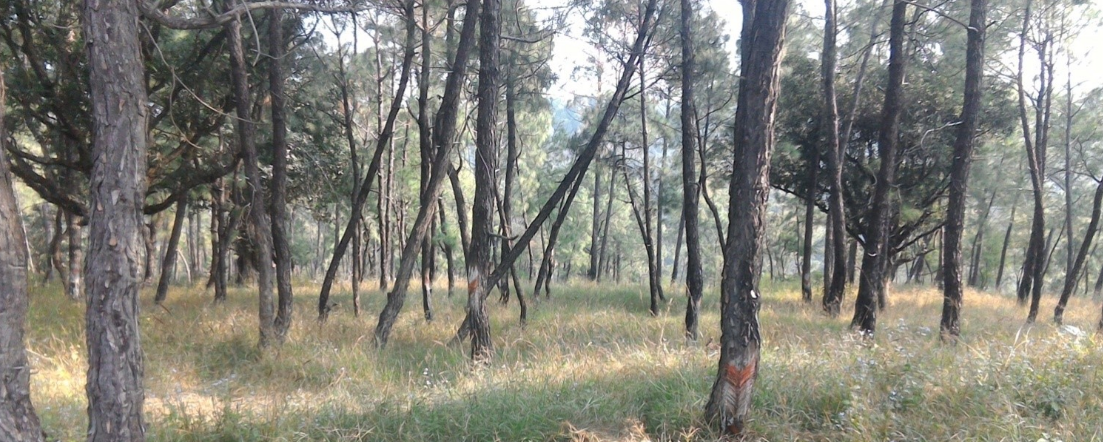Creating Climate-Resilient Communities in Mid-Hills: Interventions Towards Forest, Water & Livelihood Security
Funding Agency: National Mission on Himalayan Studies (NMHS), Govt. of India
Duration: 3 years
Project Lead: Dr. Vishal Singh
Field Site: Nainital District, Uttarakhand
In the mid-Hills of the Uttarakhand Himalayas, agriculture, animal husbandry, and NTFP commerce are all strongly linked to forests and water security. Approximately 78% of the population practice hill agriculture and are heavily dependent on forests for a large range of goods (both for subsistence and cash). The degree of dependency increases with the poverty-level and lack of access to modern amenities among the rural communities. Moreover, the climate change impacts, depletion of glaciers, increasing frequency of natural disasters, unsustainable use and degradation of watersheds are reducing water availability, changing the
seasonal flow patterns and increasing conflicts over dwindling natural resources. Besides warming, the Uttarakhand Himalayas are also experiencing dramatic change that is triggered by rapid economic growth, manifested in land-use change, increased tourism and inefficient market linkages, changing employment patterns and increased commercial dependence on forests. Thus globalization and increased mobility have exacerbated the marginality of the mountain valleys in some ways, though they have created new opportunities outside the region.
The project aims to address these challenges by developing and implementing need-based choices to build resilience against climate change in forest-dependent rural communities in Uttarakhand hill districts. It seeks a union between conservation and the local economy involving interaction amongst biophysical, social and economic components. The project activities focus on first understanding the ground realities through participatory socio-hydro-ecological research and vulnerability assessments. It then explores and implements demand-driven viable solutions in consultation with community leaders, which connect forests and water to provide improved livelihoods, strengthen inter-institutional linkages and train a new generation of youth climate leaders.
Planning Plantations: Past Learning, Toward Triple Wins in Carbon, Biodiversity and Livelihood
Funding Agency: National Academy of Sciences, Washington, DC
Duration: 1 Year
Project Lead: Dr. Rajesh Thadani
Field Site: Kangra District, Himachal Pradesh

India’s forest is a house globally important biodiversity and carbon stocks. The country has a long history of large-scale afforestation programs enabling measurement of long-term outcomes. Through the Green India Mission, it has also committed to massive afforestation programs in the coming years with potential of creating carbon sinks amounting to 2.5-3 billion tonnes of CO2 equivalent. Thirdly, a large number of people at the base of the pyramid in India meet their daily livelihood needs from forests, and they represent a significant share of the poorest people in the world.
This project will address an important research gap by assessing the success of afforestation projects against their three intended goals of forest carbon storage, ecosystem health and ecosystem services for rural livelihoods. It will provide important data on carbon and biodiversity in plantations of multiple age cohorts in diverse ecological types, and develop methodological innovations for analysis of carbon storage, biodiversity, and the relationships to land cover and livelihoods.
On the ground, research will study forest plantations established between 1985 and 2015 in different altitudinal and ecological zones in Kangra district in the Indian Himalayan state of Himachal Pradesh to determine their biodiversity and standing tree and soil carbon storage potential, relative to natural adjoining forests. The relationship between carbon storage, biodiversity, and rural livelihoods will be assessed through multidisciplinary techniques (including combining satellite remote-sensing with in-situ sociological and environmental data) and drawing on previous U.S Government-supported research on ‘Impacts of Afforestation on the Provision of Ecosystem Services to Rural Communities in India’.
Review of Assisted Natural Regeneration (ANR) with Reference to Central India
Funding Agency: The Nature Conservancy-India (TNC-India)
Duration: 1 Year
Project Lead: Mr. Chetan Agarwal
Field Site: India
Healthy forests produce both ecological and economic benefits by providing sequestration and storage of carbon in addition to numerous other ecosystem services. With the ever-increasing threat of climate change, it is important to recognize forward-thinking management strategies that aim to maintain sustainable forest productivity. One such strategy, referred to as assisted natural regeneration (ANR), is a practice to convert degraded lands into more productive forests with the provision of ecosystem services. India has set ambitious targets for the restoration of degraded lands including forest lands – recently increasing the target from 21 to 26 million hectares by 2030. In this context, Assisted Natural Regeneration (ANR) is a cost-effective strategy for the regeneration of forests that leverages existing rootstock and seed sources for re-growth of forests and supplements it with the planting of saplings in gaps. To be effective, ANR (and indeed any other approach) needs to be supported by a reduction in the factors causing degradation in the first place, protection, and supportive silvicultural practices. India has explored many approaches over the decades to try and protect its forests – from putting forest in the concurrent list and bringing the Forest Conservation Act, to promoting Joint Forest Management and subsequently the Forest Rights Act, and enhancing the effort at plantation and regeneration.

This scoping study will review the ANR practices in the country, identify potential ANR opportunities and make recommendations for promoting and implementing ANR in India.